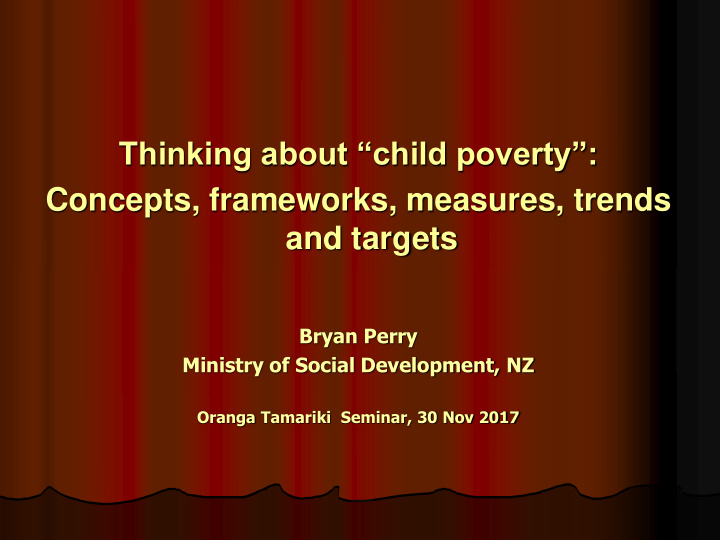



Thinking about “child poverty”: Concepts, frameworks, measures, trends and targets Bryan Perry Ministry of Social Development, NZ Oranga Tamariki Seminar, 30 Nov 2017
Material wellbeing – part of wider wellbeing • Starting point for “child poverty” thinking is wellbeing more generally • Many (child) wellbeing frameworks – OT framework (Daniel) – others • Material wellbeing impacts on most other wellbeing domains / outcomes – correlation / causation / confounding variables – not deterministic Bryan Perry, Nov 2017
“Child” poverty? • “The child income poverty rate is 15% [on a certain measure] ” is shorthand for: – “15% of children live in families / households whose total income is less than ….” • “The child hardship rate is 13% [on a certain measure] ” is shorthand for: – “13% of children live in families / households that are identified as in hardship [on the measure used]” Bryan Perry, Nov 2017
Poverty is about resources being inadequate to meet basic material needs… • “Exclusion from a minimum acceptable standard of living (level of MWB) because of inadequate household financial and material resources” • An unacceptable state-of- affairs …. a moral imperative to take action …because of: here and now suffering, commitment to care for those unable to care for themselves, international commitments potential negative impact on other aspects of wellbeing in childhood potential negative impact on outcomes in adulthood Bryan Perry, Nov 2017
• Basic material needs? • Minimum acceptable SoL? • Inadequate resources? Bryan Perry, Nov 2017
“Basic material needs” • clean drinking water • sanitation and waste disposal • adequate food • hot running water • suitable clothes and shoes • adequate housing – shelter / warmth • dental and medical care as required • mains electricity or equivalent • household durable goods – food storage and cooking, sleeping, cleaning and maintenance, having people around, …… • transport (for employment, supplies, ‘helping’, children …., leisure) • minimum ICT • social engagement that involves financial cost • financial resources to cope with unexpected essential expenses • [freedom to purchase desired non-essentials] Bryan Perry, Nov 2017
A framework for measurement Household income Discretionary spend / desirable Resources non-essentials available for consumption Basic needs / Financial and essentials physical assets Material Other factors wellbeing or eg assistance from outside the household (family, whanau, living standards community, state), high or unexpected health or debt servicing costs, lifestyle choices, ability to access available resources Bryan Perry, Nov 2017
MSD poverty & hardship measurement • primary - AHC income, 50% and 60% of median, anchored 2007 - two levels of material hardship, using the MWI / DEP-17 - accommodation conditions (warm, dry, not crowded) • secondary - AHC income, 40%, 50% & 60% of contemporary median - BHC income, 50% & 60% of contemporary median - AHC 60% crossed with MWI • international - EU-13 - BHC 50% and 60% of median … with great reluctance Bryan Perry, Nov 2017
… but we need to monitor causes as well • Economy / labour market - % children in workless households - % poor children in households with at least one in FT employment - wage rates • Safety net / policy settings - levels of main benefits and minimum wage - other income support - in-kind support / subsidies • Health of parent(s) / adults and children in household • Other household dynamics and adult ‘behaviour’ • Wider support networks Bryan Perry, Nov 2017
… and look to the future … Bryan Perry, Nov 2017
Low income rates (AHC) – children Bryan Perry, Sep 2017
Material hardship rates – children Bryan Perry, Sep 2017
UN Sustainable Development Goals? • “reduce by at least half on national measures” • an example for children (0-17 yrs) – BHC 50% moving line currently ~14-15% (~160,000) – current and former PM committed to reducing by 100,000 – this is around 5% Bryan Perry, Nov 2017
Recommend
More recommend